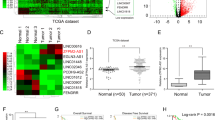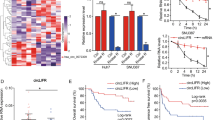Abstract
Background
The aim of our study was to explore how C1QTNF1-AS1 regulated miR-221-3p/SOCS3 axis in human hepatocellular carcinoma (HCC).
Methods
Differentially expressed lncRNAs and genes were examined via RNA-seq. GO analysis and KEGG pathway enrichment analysis were carried out based on the function of dys-regulated mRNAs. RT-qPCR was employed to detect the relative mRNA expression level of C1QTNF1-AS1, miR-221-3p, SOCS3 and key genes in the JAK/STAT signaling pathway in HCC tissues and cells, and western blot analysis was conducted to detect the relative protein expression levels of SOCS3 and key proteins in the JAK/STAT signaling pathway in HCC tissues and cells. MTT assay, transwell assay and flow cytometry were utilized to assess HCC cell proliferation, invasion, migration and apoptosis. Dual luciferase reporter gene assay was used to verify the targeted relationship between C1QTNF1-AS1 and miR-221-3p, as well as between miR-221-3p and SOCS3. A tumorigenicity assay in nude mice was conducted to investigate the effects of C1QTNF1-AS1 on HCC tumor growth in vivo.
Results
C1QTNF1-AS1 and SOCS3 were down-regulated, while miR-221-3p was up-regulated in HCC tissues and cells. In HepG2 and Huh7 cells, overexpression of C1QTNF1-AS1 or SOCS3, as well as silence of miR-221-3p inhibited HCC cell proliferation, migration, and invasion and promoted HCC cell apoptosis. The results of the dual luciferase reporter gene assay indicated that miR-221-3p could directly target both C1QTNF1-AS1 and SOCS3. In addition, up-regulation of C1QTNF1-AS1 suppressed HCC tumor growth in vivo.
Conclusion
Overexpression of C1QTNF1-AS1 down-regulated miR-221-3p and subsequently up-regulated SOCS3, thereby inhibiting HCC cell proliferation, migration and invasion and promoting apoptosis through the JAK/STAT signaling pathway.






Similar content being viewed by others
References
Ge Y, Yan X, Jin Y, Yang X, Yu X, Zhou L, et al. MiRNA-192 [corrected] and miRNA-204 directly suppress lncRNA HOTTIP and interrupt GLS1-mediated glutaminolysis in hepatocellular carcinoma. PLoS Genet 2015;11(12):e1005726. https://doi.org/10.1371/journal.pgen.1005726 (PubMed PMID: 26710269; PubMed Central PMCID: PMCPMC4692503)
Zhuang LK, Yang YT, Ma X, Han B, Wang ZS, Zhao QY, et al. MicroRNA-92b promotes hepatocellular carcinoma progression by targeting Smad7 and is mediated by long non-coding RNA XIST. Cell Death Dis 2016;7:e2203. https://doi.org/10.1038/cddis.2016.100 (PubMed PMID: 27100897; PubMed Central PMCID: PMCPMC4855645)
Tan S, Li R, Ding K, Lobie PE, Zhu T. miR-198 inhibits migration and invasion of hepatocellular carcinoma cells by targeting the HGF/c-MET pathway. FEBS Lett 2011;585(14):2229–2234. https://doi.org/10.1016/j.febslet.2011.05.042 (PubMed PMID: 21658389)
Wang Y, He L, Du Y, Zhu P, Huang G, Luo J, et al. The long noncoding RNA lncTCF7 promotes self-renewal of human liver cancer stem cells through activation of Wnt signaling. Cell Stem Cell 2015;16(4):413–425. https://doi.org/10.1016/j.stem.2015.03.003 (PubMed PMID: 25842979)
Yang F, Huo XS, Yuan SX, Zhang L, Zhou WP, Wang F, et al. Repression of the long noncoding RNA-LET by histone deacetylase 3 contributes to hypoxia-mediated metastasis. Mol Cell 2013;49(6):1083–1096. https://doi.org/10.1016/j.molcel.2013.01.010 (PubMed PMID: 23395002)
Wang F, Ying HQ, He BS, Pan YQ, Deng QW, Sun HL, et al. Upregulated lncRNA-UCA1 contributes to progression of hepatocellular carcinoma through inhibition of miR-216b and activation of FGFR1/ERK signaling pathway. Oncotarget 2015;6(10):7899–7917. https://doi.org/10.18632/oncotarget.3219 (PubMed PMID: 25760077; PubMed Central PMCID: PMCPMC4480724)
Yuan JH, Yang F, Wang F, Ma JZ, Guo YJ, Tao QF, et al. A long noncoding RNA activated by TGF-beta promotes the invasion-metastasis cascade in hepatocellular carcinoma. Cancer Cell 2014;25(5):666–681. https://doi.org/10.1016/j.ccr.2014.03.010 (PubMed PMID: 24768205)
Deng L, Lei Q, Wang Y, Wang Z, Xie G, Zhong X, et al. Downregulation of miR-221-3p and upregulation of its target gene PARP1 are prognostic biomarkers for triple negative breast cancer patients and associated with poor prognosis. Oncotarget 2017;8(65):108712–108725. https://doi.org/10.18632/oncotarget.21561 (PubMed PMID: 29312562; PubMed Central PMCID: PMCPMC5752475)
Zhou L, Yang ZX, Song WJ, Li QJ, Yang F, Wang DS, et al. MicroRNA-21 regulates the migration and invasion of a stem-like population in hepatocellular carcinoma. Int J Oncol 2013;43(2):661–669. https://doi.org/10.3892/ijo.2013.1965 (PubMed PMID: 23708209)
Li F, Xu JW, Wang L, Liu H, Yan Y, Hu SY. MicroRNA-221-3p is up-regulated and serves as a potential biomarker in pancreatic cancer. Artif Cells Nanomed Biotechnol 2018;46(3):482–487. https://doi.org/10.1080/21691401.2017.1315429 (PubMed PMID: 28434388)
Cohney SJ, Sanden D, Cacalano NA, Yoshimura A, Mui A, Migone TS, et al. SOCS-3 is tyrosine phosphorylated in response to interleukin-2 and suppresses STAT5 phosphorylation and lymphocyte proliferation. Mol Cell Biol 1999;19(7):4980–4988 (PubMed PMID: 10373548; PubMed Central PMCID: PMCPMC84319)
Niwa Y, Kanda H, Shikauchi Y, Saiura A, Matsubara K, Kitagawa T, et al. Methylation silencing of SOCS-3 promotes cell growth and migration by enhancing JAK/STAT and FAK signalings in human hepatocellular carcinoma. Oncogene 2005;24(42):6406–6417. https://doi.org/10.1038/sj.onc.1208788 (PubMed PMID: 16007195)
Wang J, Wang Y, Sun D, Bu J, Ren F, Liu B, et al. miR-455-5p promotes cell growth and invasion by targeting SOCO3 in non-small cell lung cancer. Oncotarget 2017;8(70):114956–114965. https://doi.org/10.18632/oncotarget.22565 (PubMed PMID: 29383133; PubMed Central PMCID: PMCPMC5777745)
Xu G, Yang F, Ding CL, Wang J, Zhao P, Wang W, et al. MiR-221 accentuates IFNs anti-HCV effect by downregulating SOCS1 and SOCS3. Virology 2014;462–463:343–350. https://doi.org/10.1016/j.virol.2014.06.024 (PubMed PMID: 25019494)
Deng L, Yang SB, Xu FF, Zhang JH. Long noncoding RNA CCAT1 promotes hepatocellular carcinoma progression by functioning as let-7 sponge. J Exp Clin Cancer Res 2015;34:18. https://doi.org/10.1186/s13046-015-0136-7 (PubMed PMID: 25884472; PubMed Central PMCID: PMCPMC4339002)
Quagliata L, Matter MS, Piscuoglio S, Arabi L, Ruiz C, Procino A, et al. Long noncoding RNA HOTTIP/HOXA13 expression is associated with disease progression and predicts outcome in hepatocellular carcinoma patients. Hepatology 2014;59(3):911–923. https://doi.org/10.1002/hep.26740 (PubMed PMID: 24114970; PubMed Central PMCID: PMCPMC3943759)
Li G, Zhang H, Wan X, Yang X, Zhu C, Wang A, et al. Long noncoding RNA plays a key role in metastasis and prognosis of hepatocellular carcinoma. Biomed Res Int 2014;2014:780521. https://doi.org/10.1155/2014/780521 (PubMed PMID: 24757675; PubMed Central PMCID: PMCPMC3976793)
Han L, Kong R, Yin DD, Zhang EB, Xu TP, De W, et al. Low expression of long noncoding RNA GAS6-AS1 predicts a poor prognosis in patients with NSCLC. Med Oncol 2013;30(4):694. https://doi.org/10.1007/s12032-013-0694-5 (PubMed PMID: 23979857)
Fagerberg L, Hallstrom BM, Oksvold P, Kampf C, Djureinovic D, Odeberg J, et al. Analysis of the human tissue-specific expression by genome-wide integration of transcriptomics and antibody-based proteomics. Mol Cell Proteom 2014;13(2):397–406. https://doi.org/10.1074/mcp.M113.035600 (PubMed PMID: 24309898; PubMed Central PMCID: PMCPMC3916642)
Yoon JH, Abdelmohsen K, Gorospe M. Functional interactions among microRNAs and long noncoding RNAs. Semin Cell Dev Biol 2014;34:9–14. https://doi.org/10.1016/j.semcdb.2014.05.015 (PubMed PMID: 24965208; PubMed Central PMCID: PMCPMC4163095)
Zhao L, Zou D, Wei X, Wang L, Zhang Y, Liu S, et al. MiRNA-221-3p desensitizes pancreatic cancer cells to 5-fluorouracil by targeting RB1. Tumour Biol 2016. https://doi.org/10.1007/s13277-016-5445-8 (PubMed PMID: 27726102)
Tao K, Yang J, Guo Z, Hu Y, Sheng H, Gao H, et al. Prognostic value of miR-221-3p, miR-342-3p and miR-491-5p expression in colon cancer. Am J Transl Res 2014;6(4):391–401 (PubMed PMID: 25075256; PubMed Central PMCID: PMCPMC4113501)
Guo F, Xu Z, Zhang Y, Jiang P, Huang G, Chen S, et al. FXR induces SOCS3 and suppresses hepatocellular carcinoma. Oncotarget 2015;6(33):34606–34616. https://doi.org/10.18632/oncotarget.5314 (PubMed PMID: 26416445; PubMed Central PMCID: PMCPMC4741476)
Patel K, Kollory A, Takashima A, Sarkar S, Faller DV, Ghosh SK. MicroRNA let-7 downregulates STAT3 phosphorylation in pancreatic cancer cells by increasing SOCS3 expression. Cancer Lett 2014;347(1):54–64. https://doi.org/10.1016/j.canlet.2014.01.020 (PubMed PMID: 24491408; PubMed Central PMCID: PMCPMC3972339)
Collins AS, McCoy CE, Lloyd AT, O'Farrelly C, Stevenson NJ. miR-19a: an effective regulator of SOCS3 and enhancer of JAK-STAT signalling. PLoS One 2013;8(7):e69090. https://doi.org/10.1371/journal.pone.0069090 (PubMed PMID: 23894411; PubMed Central PMCID: PMCPMC3718810)
Zhang YP, Li YQ, Lv YT, Wang JM. Effect of curcumin on the proliferation, apoptosis, migration, and invasion of human melanoma A375 cells. Genet Mol Res 2015;14(1):1056–1067. https://doi.org/10.4238/2015.February.6.9 (PubMed PMID: 25730045)
Stevenson NJ, McFarlane C, Ong ST, Nahlik K, Kelvin A, Addley MR, et al. Suppressor of cytokine signalling (SOCS) 1 and 3 enhance cell adhesion and inhibit migration towards the chemokine eotaxin/CCL11. FEBS Lett 2010;584(21):4469–4474. https://doi.org/10.1016/j.febslet.2010.10.007 (PubMed PMID: 20934424)
Funding
None.
Author information
Authors and Affiliations
Corresponding author
Ethics declarations
Conflict of interest
Hang Li, Bo Zhang, Meng Ding, Shang Lu, Hui Zhou, Dajun Sun, Gang Wu and Xianfeng Gan declare that they have no competing interests.
Ethics approval
All procedures performed in studies involving animal participants were in accordance with the ethical standards of China-Japan Union Hospital, Jilin University. The entire study was approved by the China-Japan Union Hospital, Jilin University.
Informed consent
Informed consent was collected from patients to approve utilization of their tissues for research purposes.
Additional information
Publisher's Note
Springer Nature remains neutral with regard to jurisdictional claims in published maps and institutional affiliations.
Electronic supplementary material
Below is the link to the electronic supplementary material.
12072_2019_9944_MOESM4_ESM.tif
Supplementary Figure 1 RNA-seq analysis defined down-regulation of C1QTNF1-AS1 and SOCS3 in HCC tissues. (A) (B) Mass fraction diagram of sample base sequences; (C) Heatmap of the ten most up-regulated and down-regulated mRNAs in normal and tumor tissues, in which SOCS3 was included; (D) Heatmap of the ten most up-regulated and down-regulated lncRNAs in normal and tumor tissues, in which C1QTNF1-AS1 was included (TIF 22440 kb)
12072_2019_9944_MOESM5_ESM.tif
Supplementary Figure 2 GO function enrichment and pathway enrichment analysis. (A)(B)(C) GO function analysis cluster diagram. A higher z-score represents an increase in function expression; (D) KEGG analysis revealed the different biological functions in cancer and normal samples; (E) Gene enrichment in the JAK/STAT pathway (TIF 33324 kb)
12072_2019_9944_MOESM6_ESM.tif
Supplementary Figure 3 (A) Effects of C1QTNF1-AS1 on apoptosis analysis of HCC cells; (B) Effects of C1QTNF1-AS1/miR-221-3p on apoptosis analysis of HCC cells; (C) Effects of SOCS3/miR-221-3p on apoptosis analysis of HCC cells (TIF 14187 kb)
Rights and permissions
About this article
Cite this article
Li, H., Zhang, B., Ding, M. et al. C1QTNF1-AS1 regulates the occurrence and development of hepatocellular carcinoma by regulating miR-221-3p/SOCS3. Hepatol Int 13, 277–292 (2019). https://doi.org/10.1007/s12072-019-09944-5
Received:
Accepted:
Published:
Issue Date:
DOI: https://doi.org/10.1007/s12072-019-09944-5




